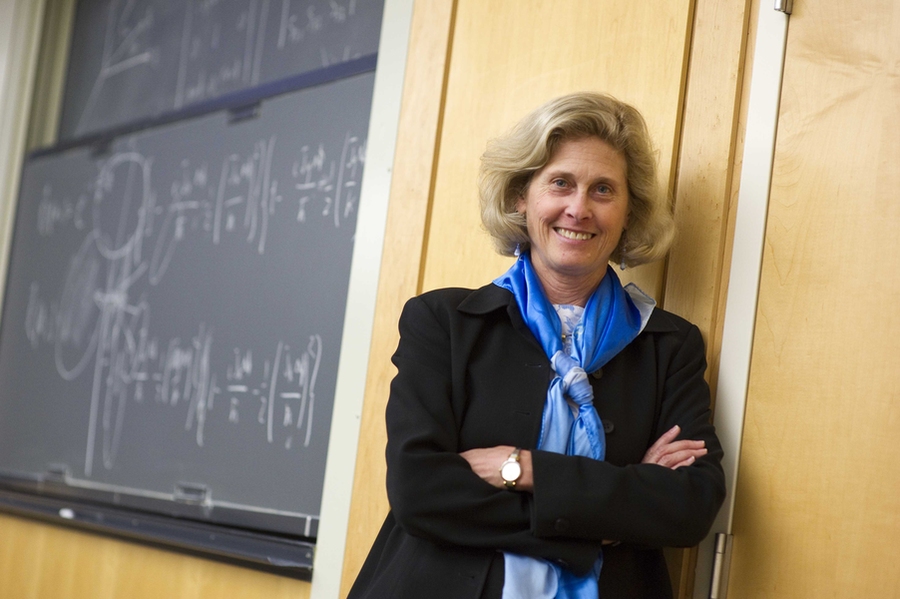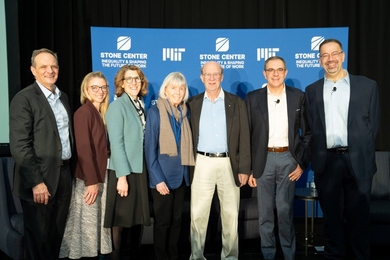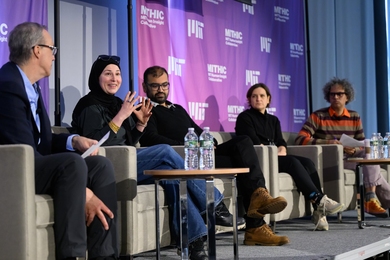Since the dawn of the nuclear age, and particularly since the advent of nuclear power generation, engineers and scientists have had to confront the issue of nuclear proliferation — the potential spread of nuclear weapons, materials and technologies to non-nuclear nations and subnational groups. Carol Kessler, who earned her SM in 1982 in nuclear science and engineering and technology and policy, has focused her professional life on technological and diplomatic approaches to this globally critical issue: She spent 12 years as a policy developer and negotiator at the U.S. State Department, and has held leadership positions at the Nuclear Energy Agency in Paris, the Pacific Northwest National Laboratory and Brookhaven National Laboratory, where she currently chairs the Nonproliferation and National Security Department. Kessler answered our questions during a recent campus visit, when she spoke to students about careers in nonproliferation.
Q. What are the biggest challenges for nonproliferation, near term and long term?
A. Near term, the biggest need is securing nuclear and radiological materials that could be trafficked. It’s certainly on the presidential agenda, and I hope the budgets keep up.
One of the biggest issues is that, when the Soviet Union fell apart, a very strict security environment was disrupted. Since then, they’ve gotten it back to some extent, but there’s still a need for better physical access barriers — fences and locks and security guards, and also provisions against internal threats. It’s a question of helping people there see value in creating and maintaining a new security culture.
And in the near, medium and long term, the big challenges are Iran, North Korea and possibly Syria. They’re all difficult in their own ways.
North Korea is isolated and struggling; it doesn’t care about the rest of the world, and it feels like the rest of the world doesn’t care about it. Iran is more integrated, but complex because it has its eye on playing a leadership role in the Middle East. Syria is complicated: [In early October] Russia and China vetoed a sanction measure at the UN. Did they do that because they think Syria is behaving acceptably, or because they were afraid that support for intervention in Syria might come back to bite them?
The real question is, can we provide sufficient security guarantees to those countries when they don’t trust us and we don’t always trust them?
Q. You've worked at national labs, which are focused on technology, but also in situations where you addressed technological issues with nontechnical people. What are the challenges and rewards in those two environments?
A. Nonproliferation requires a marriage between technical people and policy people. I have a penchant for policy, but MIT opened me up to understand the technical issues in much more depth.
For instance, at Brookhaven, we have a group developing room-temperature radiation detectors, using semiconducting crystals. These detectors are impressively sensitive, and more effective than detectors in common use, which require liquid nitrogen for cooling. Having been on the diplomatic side, I know how important that is, because when you set out as an international inspector, you’re looking for things that a country has not disclosed. It’s difficult enough without worrying about where to store your liquid nitrogen.
Much of my policy work concerned advancement of foreign policy with highly technical solutions — ways of verifying countries’ peaceful-use commitments using international safeguards, or finding a solution for covering the Chernobyl reactor. Without technology there’s no way forward, but as I found out, you have to convince a minister of the environment who has no nuclear background that the solution makes sense. So you need that organizational combination of diplomatic, policy and technology expertise.
Q. You've talked about how, in the course of the Chernobyl negotiations, you came to realize that Soviet-era officials had different senses of risk than we do in the West. How did you figure that out? And what did you and your colleagues do with that knowledge?
A. We’d been working with Ukrainian and Russian officials for several years when it finally crystallized one night in 1996. My deputy, John Dobrin, and I were working late on a briefing paper for President Clinton, who was meeting the next day with Russian President Boris Yeltsin. When you’re briefing the president, you get one page, and we were struggling to explain why the Russian Federation was reluctant to stop operating Chernobyl-style reactors, which appear incredibly dangerous to Western eyes.
John and I had seen how senior Soviet officials just accepted that many deaths would happen on public-works projects, like bridges and subways, and how plant workers would take risks with nuclear material and walk right into radioactive areas, to show they weren’t afraid of radiation. And that night, John said, they just have a very different perspective on risks to people.
So our first paragraph stated that the gulf between the United States and Russia was our different perceptions of risk, and that we couldn’t move forward on nuclear safety until Russia believed it could no longer afford to risk its people. It was an example of how diplomatic, technical and policy issues affect one another. If you can get inside the other person’s thinking, you can find a way forward.
A friend was at the summit meeting the next day, and told us that President Clinton used our exact words with President Yeltsin. The Russians are still less risk-averse, and their old reactors just got a new bill of health. However, though it took a while, we did get Ukraine’s agreement to close Chernobyl by agreeing to pay for building a new “sarcophagus” over the accident site. I’m proud of that outcome.
Q. What are the biggest challenges for nonproliferation, near term and long term?
A. Near term, the biggest need is securing nuclear and radiological materials that could be trafficked. It’s certainly on the presidential agenda, and I hope the budgets keep up.
One of the biggest issues is that, when the Soviet Union fell apart, a very strict security environment was disrupted. Since then, they’ve gotten it back to some extent, but there’s still a need for better physical access barriers — fences and locks and security guards, and also provisions against internal threats. It’s a question of helping people there see value in creating and maintaining a new security culture.
And in the near, medium and long term, the big challenges are Iran, North Korea and possibly Syria. They’re all difficult in their own ways.
North Korea is isolated and struggling; it doesn’t care about the rest of the world, and it feels like the rest of the world doesn’t care about it. Iran is more integrated, but complex because it has its eye on playing a leadership role in the Middle East. Syria is complicated: [In early October] Russia and China vetoed a sanction measure at the UN. Did they do that because they think Syria is behaving acceptably, or because they were afraid that support for intervention in Syria might come back to bite them?
The real question is, can we provide sufficient security guarantees to those countries when they don’t trust us and we don’t always trust them?
Q. You've worked at national labs, which are focused on technology, but also in situations where you addressed technological issues with nontechnical people. What are the challenges and rewards in those two environments?
A. Nonproliferation requires a marriage between technical people and policy people. I have a penchant for policy, but MIT opened me up to understand the technical issues in much more depth.
For instance, at Brookhaven, we have a group developing room-temperature radiation detectors, using semiconducting crystals. These detectors are impressively sensitive, and more effective than detectors in common use, which require liquid nitrogen for cooling. Having been on the diplomatic side, I know how important that is, because when you set out as an international inspector, you’re looking for things that a country has not disclosed. It’s difficult enough without worrying about where to store your liquid nitrogen.
Much of my policy work concerned advancement of foreign policy with highly technical solutions — ways of verifying countries’ peaceful-use commitments using international safeguards, or finding a solution for covering the Chernobyl reactor. Without technology there’s no way forward, but as I found out, you have to convince a minister of the environment who has no nuclear background that the solution makes sense. So you need that organizational combination of diplomatic, policy and technology expertise.
Q. You've talked about how, in the course of the Chernobyl negotiations, you came to realize that Soviet-era officials had different senses of risk than we do in the West. How did you figure that out? And what did you and your colleagues do with that knowledge?
A. We’d been working with Ukrainian and Russian officials for several years when it finally crystallized one night in 1996. My deputy, John Dobrin, and I were working late on a briefing paper for President Clinton, who was meeting the next day with Russian President Boris Yeltsin. When you’re briefing the president, you get one page, and we were struggling to explain why the Russian Federation was reluctant to stop operating Chernobyl-style reactors, which appear incredibly dangerous to Western eyes.
John and I had seen how senior Soviet officials just accepted that many deaths would happen on public-works projects, like bridges and subways, and how plant workers would take risks with nuclear material and walk right into radioactive areas, to show they weren’t afraid of radiation. And that night, John said, they just have a very different perspective on risks to people.
So our first paragraph stated that the gulf between the United States and Russia was our different perceptions of risk, and that we couldn’t move forward on nuclear safety until Russia believed it could no longer afford to risk its people. It was an example of how diplomatic, technical and policy issues affect one another. If you can get inside the other person’s thinking, you can find a way forward.
A friend was at the summit meeting the next day, and told us that President Clinton used our exact words with President Yeltsin. The Russians are still less risk-averse, and their old reactors just got a new bill of health. However, though it took a while, we did get Ukraine’s agreement to close Chernobyl by agreeing to pay for building a new “sarcophagus” over the accident site. I’m proud of that outcome.






